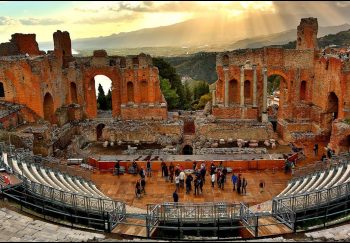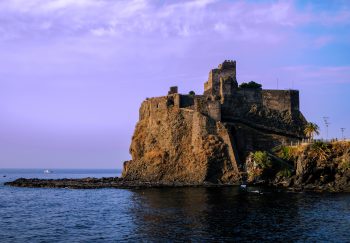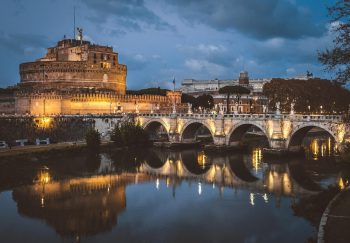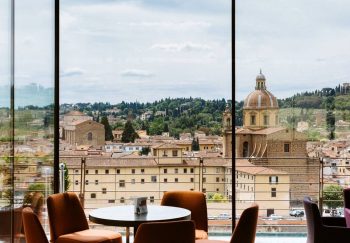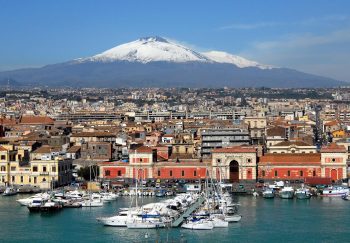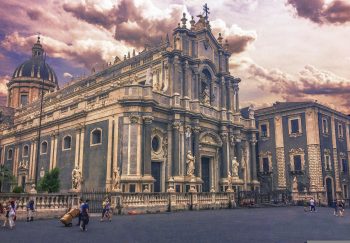Every year, Catania has been experiencing a unique experience every year for centuries. The three days of ” Santuzza“, as it is known locally, are a whirlwind full of intense emotions that attract thousands of devotees and curious people each year.
A celebration of faith, tradition, and devotion. The only comparable Feast can be the Holy Week, Seville, Spain or the Corpus Domini, Cuzco, Peru.
The town buzzes with excitement for the patron Saint’s Festival, the young Agata from Catania, who is a Virgin, Martyr, and Young Agata. Her captivating story will touch every heart. The young, beautiful Christian girl from an aristocratic background resisted Quintianus’ flattery and fought against any abuse of power to protect her faith and moral integrity. This choice came with painful martyrdoms, including the cutting of her breast and her own life.
Sant’Agata at the Cathedral – Ph. Giuseppe Russo
We will remember her for her miraculous acts in preventing earthquakes, volcano eruptions and other epidemics that affected Catania. According to legend, the city was under threat from a volcanic eruption on February 1, 252 (Agata had already died a year earlier). Fearful, the inhabitants of nearby villages took the veil wrapped around Agata’s tomb and used it to protect themselves from the lava flow. The eruption was stopped abruptly by the sudden color change of the white veil. It was the anniversary of her martyrdom on February 5, 2005.
“Candelora”, fishmongers guild – Ph. Giuseppe Russo
The Festival starts February 3rd. It begins with a solemn noon procession from the Church of Sant’Agata alla Fornace to the Cathedral. This is where the offering of wax rite takes places. Eleven large candles represent local guilds. Two Senate carriages complete the procession. An eighteenth century sedan is followed by a smaller car that transports the city’s administrators.
The spectacular fireworks display takes place in Piazza Duomo on the same night.
Fireworks show in piazza Duomo – ph. Giuseppe Russo
In the early hours of February 4, after the Massa dell’ Aurora (Dawn Holy Mass), the bust Saint Agata is taken out of the safe room within the Cathedral, where it is kept permanently. The procession is the culmination of the crowd’s anticipation. People are moved, and there is much applause and screams. A silver carriage pulls the Saint and her relics outside the city walls. The procession moves first towards Sant’Agata alla Fornace where her martyrdom occurred. Next, it heads to Sant’Agata al Carcere. There, an olive tree is located in front of the building, which recalls how the Virgin, who fled the men of Quintianus and managed to eat its fruits. The tradition of running fast while dragging the carriage up the Cappuccini slope is also an old one. In the meantime, Catania’s locals with their traditional black skullcaps (and votive white tunics) ‘u Saccu wave a white handkerchief to invoke their Patron Saint: “Tutti Devoti tutti cittadini viva Sant’Agata . (Are we all devotees? St. Agata! “And then, another fireworks show.
One of the “Candeloras” in procession – ph. Giuseppe Russo
The “peak” day of the feast is February 5, and it is always the most awaited. Afternoon, the cart departs Piazza Duomo for a tour within the city. It moves very slowly and crosses Etnea before reaching piazzaUniversita. The cart then moves towards piazza Stesicoro, and further to Villa Bellini. Piazza Cavour, or Piazza Borgo as it’s known by locals, is where the cart ends up. The “vara” crosses the San Giuliano slope and Quattro Canti after a spectacular fireworks display.
Sant’Agata in piazza Universita – ph.Giuseppe Russo
An exciting game of endurance between all candelore takes place “la Corsa del Cordone”, a cord pulled out by thousands (if all goes well, it means a good harvest next season). The race ends at Via Crociferi where the charmed singing by the Benedictine nuns pay homage to Saint. It is now almost a race to the Cathedral. But the light has already begun to shine. It is an emotional time. You can see the happiness on faces of people who have spent three days with their Patron. But, you also feel tired. They still shout with a last whispered voice, lit by the last fireworks, and exclaim: “Cittadini viva Sant’Agata!” . (Locals! ).
Saint Agata Festival, devotees- ph. Giuseppe Russo
Sant’Agata’s desserts Legend and history…
In any Catania pastry shop, sweets and cakes that relate to the Virgin’s story will be available: The cassateddi also known as minni Di Sant’Aita, whose form recalls the martyrdom of the saint (she was cut from her breast to reject Quintianus’ love for the Christian faith), and the Olivette (small olives).
Sant’Agata almond sweetness. – ph. Giovanna Gagliano
These sweet olives relate to the TELLING that a young woman fled from Quinziano’s men and hid under an olive tree that miraculously appeared out of nowhere, which gave her the opportunity to eat and relax.
The connection between Catania’s inhabitants and their Patron is also reflected in the bid number of votive Aediculesdedicated…
The August 17th feast is the most ancient. It is related to the spontaneous celebrations that took place on the 17th of August 1126. This was the night when Sant’Agata’s mortal remains were brought from Constantinople by Gisliberto (and Goselmo) and brought to Catania. Celebrations are not as grandiose as the February celebrations. A short procession is held in the afternoon. The Saint’s relics chest is paraded around the Cathedral’s vicinity, via Via Dusmet towards Piazza San Placido, and then returns to the Cathedral crossing Via Vittorio Emanuele. At Catania Port, an exceptional fireworks display takes place. The fireworks display from San Placido church’s roof is a pleasant aspect of the Festival’s summer edition.
(Sources: “S. AGATA Guida alla Festa” orazioRusso, Nino Urzi ed. 01/04; “Festa di sant’Agata” Wikipedia)
Watch the video
